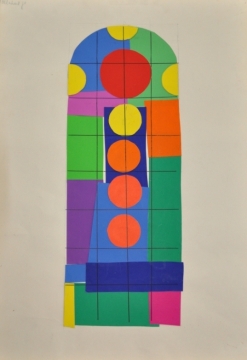After the damage caused during the Second World War, the 9th century listed church of Saint-Hadelin de Celles, built in typical Mosan style that is characteristic of this region of Namur, needed its stained-glass windows repairing during the 1970s. These 31 prototypes were commissioned from four artists adept in geometric abstraction: Jo Delahaut (1911-1992), Jean Retz (1910-1998), Louis-Marie Londot (1924-2010) and André Blank (1914-1987). The latter two artists were particularly distinguished as master glass artists during the post-war period of reconstruction.
Each artist was given 10 m² in which to work. The central choir window was entrusted to Jo Delahaut; this was the first to be designed and presented to the other artists, who then created their design. It was to be set between the two projects assigned to each of Jean Retz and Louis-Marie Londot. The work of Louis-Marie Londot concerned essentially the small windows in the apse of the choir. The four artists presented their projects using widely differing techniques: collage, print, paint, watercolour on paper or cardboard, but each managed to retain their own personal style, whilst still maintaining good overall harmony.
The drawn and coloured projects were submitted in 1970-1971, but were not retained. No doubt their abstract geometric shapes were considered too contemporary and they were abandoned in favour of more classical stained glass window designs.
Nevertheless, this project is a good example of stained glass windows in colour, designed from the 1950s onwards. During this period, numerous initiatives set out to renovate or even build new churches. The contemporary stained glass of the time introduced a note of modernity into old religious buildings and brought colour and gaiety to the new buildings.
These 31 layouts will be entrusted to the Centre d’Archives et de Documentation of the Commission Royale des Monuments, Sites et Fouilles in Liege, where they will be more accessible to the public and can be studied in greater depth.
Further information about the Léon Courtin-Marcelle Bouché Fund
